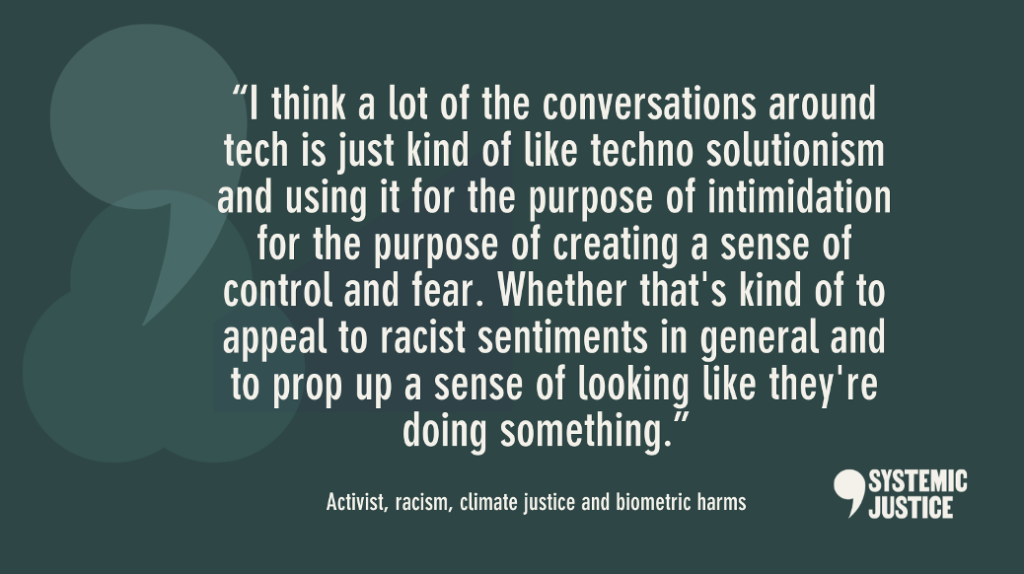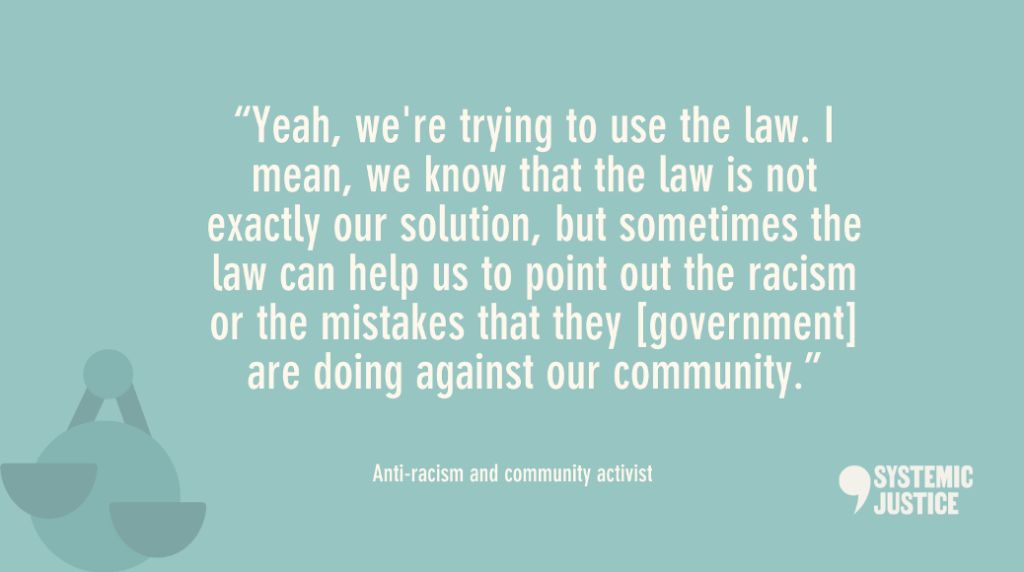We are excited to be launching “Revisiting Systemic (In)justices: Community reflections”, a report that is the product of rich conversations with people who are working with few resources to build a better world for all.
The report’s findings are critical to understanding systemic injustices in Europe, and to strengthening campaigning, advocacy, and legal strategies to secure justice for all. This blog reflects on some of its emergent findings.

Still doing much more: local and community organisations, movements, and collectives
When compared to larger and more formal organisations, local and community organisations, movements, and collectives are responding to a more complex array of problems as they affect racially, socially, and economically marginalised community members.
This is most prominent in the areas of policing, racism, and freedom of movement, where work done to resist police violence and brutality, tackle racism, and work in-service to refugees and people claiming asylum, is itself subject to significant political, police, and law enforcement attention.
The centrality of narratives of harm
“The real prevalence of stereotypes and this of course entails discrimination. You see a lot of discrimination, in employment and housing segregation, health. You see the life expectancy for Roma is 10 years younger.”
– Community organiser, Roma rights, anti-gypsyism
We found a convergence of political narratives of harm based upon the construction and presentation of stereotypical tropes, which are deliberately evoked by politicians to justify the enactment of harmful state and government practices.
Central to these tropes, is the dominance of a political mindset of scarcity which is used to defend and legitimise government policies that deny services, resources, and provisions to marginalised groups and communities – those mediated as threatening ‘our way of life’, are ‘a drain on resources’, ‘entering the country illegally’, and who pose a ‘threat to national security’. Paradoxically it is also the narrative of scarcity that promotes the continuity of harmful extractive industries for natural resources, and that grants the ‘right to pollute’ to private corporations and entities.

The promise and seduction of AI, pre-emptive, and predictive technologies
“I think a lot of the conversations around tech is just kind of like techno solutionism and using it for the purpose of intimidation for the purpose of creating a sense of control and fear. Whether that’s kind of to appeal to racist sentiments in general and to prop up a sense of looking like they’re doing something.”
– Activist, racism, climate justice and biometric harms
The encroachment of AI, pre-emptive, and predictive technologies is being weaponised in service to state institutions, government agendas and increasingly right-wing, populist appeals to monitor, surveil, and preclude those who are politicised as a threat to the normative boundaries of European societies.
The seductions of technology are today used by governments and state institutions to regulate those who are argued as being the cause of contemporary social problems. Within the report we surface how the promise of AI, pre-emptive, and predictive technologies exacerbate already existing systemic injustices by;
- identifying and (digitally) excluding racially, socially and economically marginalised groups and communities;
- erecting digital (internal and external) borders of preclusion;
- concealing and denying the racial, social, economic, and climate harms of systemic injustices; and
- controlling and undermining protests, resistance, and community activism against the harms of systemic injustice.
We have also found there remains a significant chasm in understandings of data and tech-harms between racially, socially, and economically marginalised communities and the ‘tech industry’. There is an urgent need to narrow this divide to enable community-led resistance against the encroachment of technologies that harm.

Building knowledge and power: the use of the law to address systemic injustices
“Yeah, we’re trying to use the law. I mean, we know that the law is not exactly our solution, but sometimes the law can help us to point out the racism or the mistakes that they [government] are doing against our community.”
– Anti-racism and community activist
Finally, we found that just over one in ten (12%) of organisations, movements, and collectives use the law to disrupt systemic injustices. Given the relationship between the drivers of (tech-enabled) systemic injustices, narratives of harm and the enduring pathological (re)construction of marginalised communities as political problems to be (re)solved, there is a clear need to counter the ‘politricks’ and stereotypical narratives that increasingly serve to legitimise the development and enactment of polices that harm.
In the final analysis, the political manipulation of scarcity amid the perpetuation of narratives of harms serves to maintain capitalist structures premised upon historical and contemporary European colonial and imperialist projects. Strategies of resistance are therefore complex, enduring, and ongoing.

We hope that the findings of “Revisiting Systemic (In)justices: Community reflections” can assist in the advocacy, campaigning, and legal strategies necessary to support communities who are resisting injustice and highlight collaborations for change, and opportunities for action.
